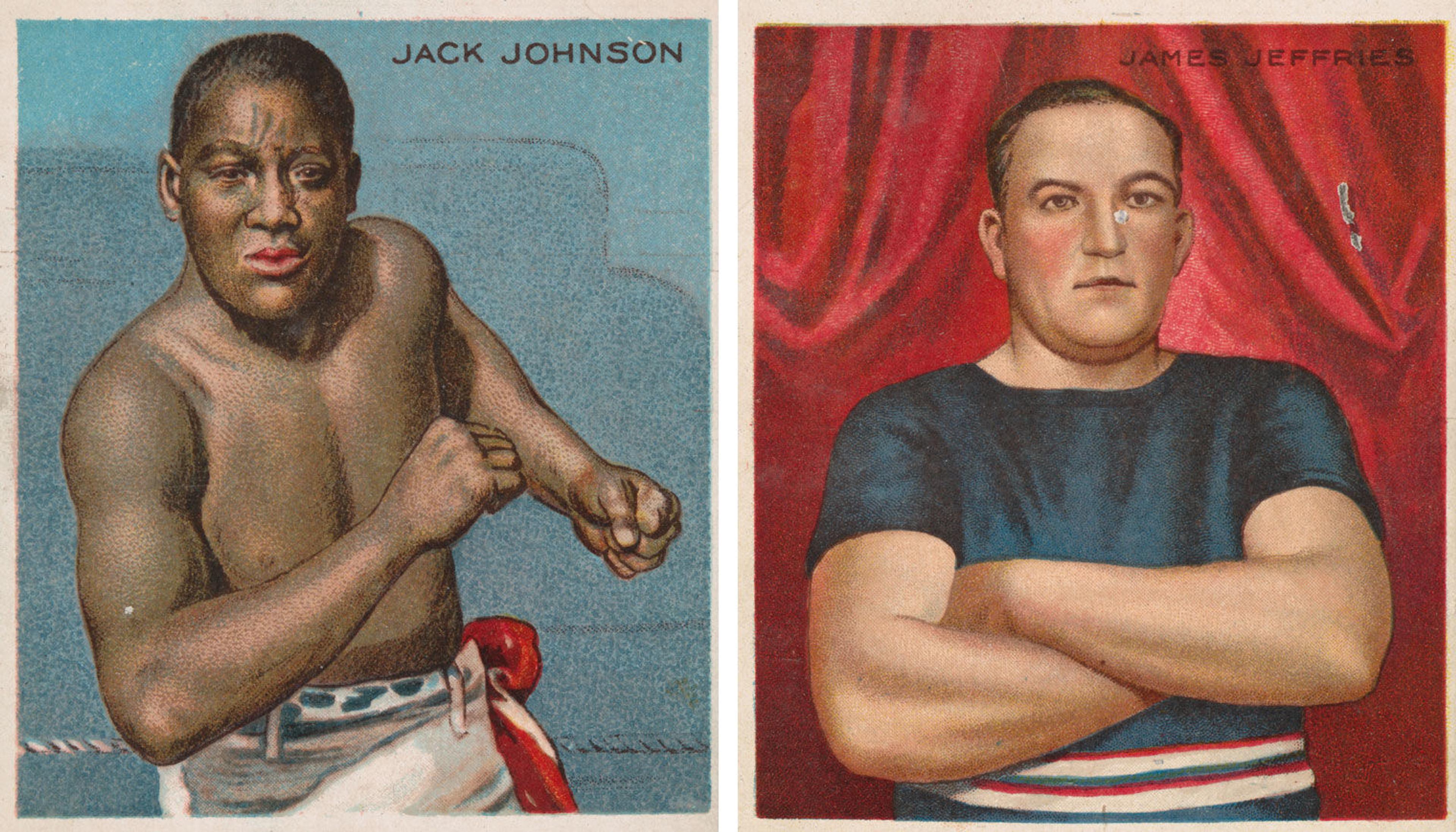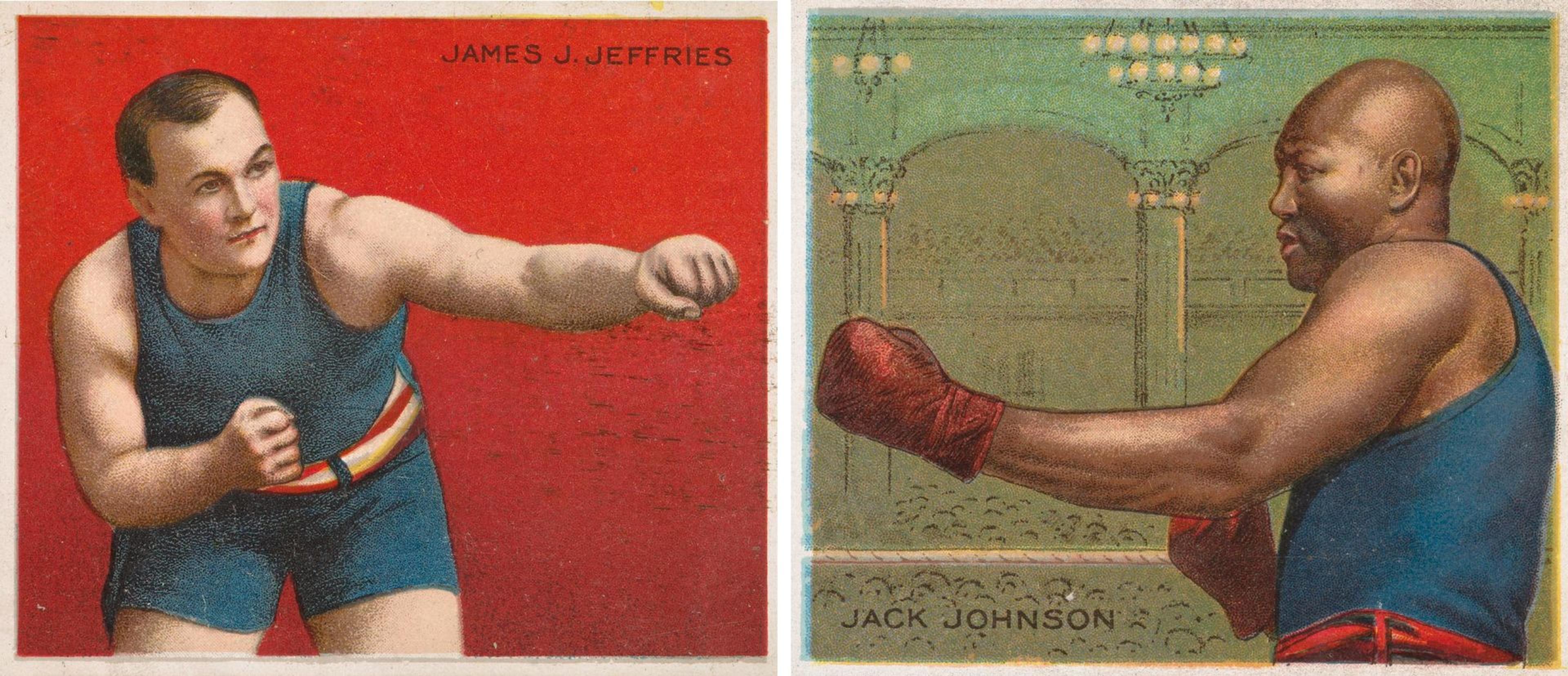Jeffries versus Johnson: The Fight of the Century

Left: Jack Johnson, Boxing, from Mecca & Hassan Champion Athlete and Prize Fighter collection, 1910. Commercial color lithograph, sheet: 2 7/8 x 2 1/2 in. (7.3 x 6.4 cm). The Metropolitan Museum of Art, New York, The Jefferson R. Burdick Collection, Gift of Jefferson R. Burdick (63.350.247.218.92). Right: James J. Jeffries, Boxing, from Mecca & Hassan Champion Athlete and Prize Fighter collection, 1910. Commercial color lithograph, sheet: 2 7/8 x 2 1/2 in. (7.3 x 6.4 cm). The Metropolitan Museum of Art, New York, The Jefferson R. Burdick Collection, Gift of Jefferson R. Burdick (63.350.247.218.91)
Jefferson R. Burdick's name has somewhat of a monumental stature in The Met's Department of Drawings and Prints. In fact, it is mentioned so regularly that a visitor might mistake him for either an artist in the collection or a curator in the department. During a span of fifteen years starting in the late 1940s, Burdick compiled his extensive collection of printed ephemera, carefully arranging more than three hundred thousand advertising inserts, postcards, and posters into corresponding album pages and sections. In organizing the albums, Burdick adhered to a strict cataloguing system that he devised and published as The American Card Catalog (first edition 1939, with revised editions appearing through 1960)—a cataloguing method that remains the standard system used by all collectors of American printed ephemera.
Burdick's collection is most famous for its baseball cards, such as the widely coveted Honus Wagner card, but the current exhibition centering on the collection, On the Ropes, focuses on boxing cards. Like baseball cards, boxing cards were typically manufactured by tobacco, candy, and gum companies as advertising insert cards during the first decades of the twentieth century and were widely collected.
In 1910, Mecca Cigarettes manufactured its stand-out collection, the Champion Athletes and Prize Fighter series which is very popular among boxing card collectors. The amount of detail in the background, the vibrant colors, and the realistic rendering of the boxers speaks to the delicate handiwork that went into illustrating these widely disseminated ephemeral objects. These characteristics also reflect the rising popularity of boxing in popular culture from 1909 to 1912, when tobacco and candy companies issued hundreds of boxing cards to mirror the sport's success in the United States.

Left: James J. Jeffries, Boxing, from Mecca & Hassan Champion Athlete and Prize Fighter collection, 1910. Commercial color lithograph, sheet: 2 1/2 x 2 7/8 in. (6.4 x 7.3 cm). The Metropolitan Museum of Art, New York, The Jefferson R. Burdick Collection, Gift of Jefferson R. Burdick (63.350.247.218.86). Right: Jack Johnson, Boxing, from Mecca & Hassan Champion Athlete and Prize Fighter collection, 1910. Commercial color lithograph, sheet: 2 1/2 x 2 7/8 in. (6.4 x 7.3 cm). The Metropolitan Museum of Art, New York, The Jefferson R. Burdick Collection, Gift of Jefferson R. Burdick (63.350.247.218.87)
What is particularly striking about the series is Burdick's decision to strategically place two of the most famous boxers—or prizefighters as they were called at that time—side by side on his album page. In one pair of cards (above), each of the boxers are dressed in royal blue uniforms with red, white, and blue sashes around their waists. They have been arranged to face one another in upright stances. These two boxers are James J. Jeffries and Jack Johnson, who battled one another in what is referred to as the "Fight of the Century."
People marketing boxing matches in the early twentieth century often exploited ethnic and racial animosities to promote fights. This inflammatory dimension of boxing worked to catapult Johnson to fame when he became the first black man to become the heavyweight champion in 1908. As soon as Johnson won the title, many boxing enthusiasts began a frantic search to find "The Great White Hope," a white American boxer who could prove that Caucasian Americans were racially and physically superior to African Americans.
On July 4, 1910, a crowd of more than twelve thousand people gathered in a makeshift stadium in Reno, Nevada, to witness James (Jim) Jeffries, try to take back the title from Johnson, the current champion. Jeffries was a white, retired heavyweight champion who came out of retirement to fight Johnson after being persuaded with a generous sum. During the fight, Johnson knocked Jeffries to the canvas twice, something that had never before happened in the latter's illustrious career. Jeffries's corner threw in the towel at the start of the fifteenth round to prevent the former champ from the humiliation of being knocked out. It was an emotionally charged event for both Jeffries, who lost his undefeated title, and for white American fans, whose "Great White Hope" not only lost a boxing match, but also lost the larger fight symbolizing racial superiority. As some newspapers and communities anticipated, race riots ensued across the country and many African Americans were injured or killed in vindictive rage. The “Fight of the Century” would be remembered as a moment that shattered white pretensions to superiority for decades to come.
While there are a number of boxing series in the Burdick collection that include cards with portraits of either Jeffries or Johnson, this Mecca Cigarettes series is the only one in the collection to include cards featuring both boxers. Burdick's placement of the cards is both an insight into the collector's thinking and an acknowledgment of the fight's sociohistorical importance.
Related Content
On the Ropes: Vintage Boxing Cards from the Jefferson R. Burdick Collection is on view at The Met Fifth Avenue through October 21, 2018.
Read another Now at The Met article in which On the Ropes curator Allison Rudnick provides readers with an overview of the themes of the exhibition.
Learn more about the Jefferson R. Burdick Collection and read an assortment of blog articles related to the collection.
Angela Pastorelli-Sosa
Angela Pastorelli-Sosa was formerly a Lifchez-Stronach curatorial intern in the Department of Drawings and Prints.